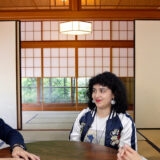
こんにちは。私は宮崎さやです。
Hallo! My name is Saya Miyazaki.

私は今、横浜にいます。

今日は一緒に、横浜を散歩しましょう。

ここは山下公園です。
I’m at the Yamashita park.

あまり人がいませんね。
There are few people.

公園に何がありますか。
What is there in the park?

公園にカフェがあります。船があります。
There’s a cafe in the park. And there is a ship.
Megumi: “Hello, Tao-san? Where are you, Tao-san?”
Tao: “Hello, Megumi-san. I’m at the park.”
Megumi: “I’m at the park too, but I can’t find you.”
Tao: “Yes, there are a lot of people in the park.”
Megumi: “Tao-san, what’s in the park?”
Tao: “Well, there’s a cafe in the park. And there is a ship.”
Megumi: “Ship… Ah!” Tao-san!”
| 公園 こうえん | park |
| 人 ひと | people |
| カフェ | café |
| 船 ふね | boat / ship |
“〜に何がありますか。” is the English equivalent of “What is there in/on/at…?” and is used when asking about something specific in a particular place or location. Before “に” (particle), you should use a noun for a place.

公園に何がありますか?
What is there in the park?
“〜に〜があります。” is the English equivalent of “There is/are… in/on/at…” and is used to state the presence of something in a specific place or location. Before “が” (particle), you should use a noun for objects or things.
Examples:

公園にカフェがあります。
There is a cafe in the park.
The word “あります” is primarily used for objects. In the case of people, we use “います.”

公園にあまり人がいませんね。
There are few people at the park.
Arrange it in the correct sequence.
1. うれしくない/ニュース (uhappy/news)
並び替えてください:
ここにドラッグして解答:
並び替えてください:
ここにドラッグして解答:
2. 心配/ないです。/あの/医者/は/こわくない/です (Don’t worry. That doctor isn’t scary.)
| うれしい (ureshī) | happy |
| ニュース (nyūsu) | news |

